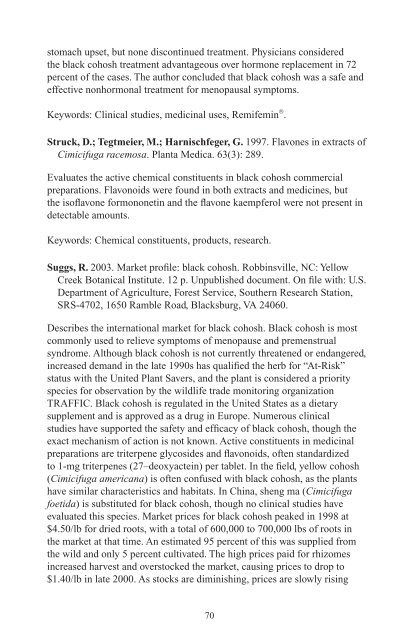Black Cohosh - Non-Timber Forest Products
Black Cohosh - Non-Timber Forest Products
Black Cohosh - Non-Timber Forest Products
Create successful ePaper yourself
Turn your PDF publications into a flip-book with our unique Google optimized e-Paper software.
stomach upset, but none discontinued treatment. Physicians considered<br />
the black cohosh treatment advantageous over hormone replacement in 72<br />
percent of the cases. The author concluded that black cohosh was a safe and<br />
effective nonhormonal treatment for menopausal symptoms.<br />
Keywords: Clinical studies, medicinal uses, Remifemin ® .<br />
Struck, D.; Tegtmeier, M.; Harnischfeger, G. 1997. Flavones in extracts of<br />
Cimicifuga racemosa. Planta Medica. 63(3): 289.<br />
Evaluates the active chemical constituents in black cohosh commercial<br />
preparations. Flavonoids were found in both extracts and medicines, but<br />
the isoflavone formononetin and the flavone kaempferol were not present in<br />
detectable amounts.<br />
Keywords: Chemical constituents, products, research.<br />
Suggs, R. 2003. Market profile: black cohosh. Robbinsville, NC: Yellow<br />
Creek Botanical Institute. 12 p. Unpublished document. On file with: U.S.<br />
Department of Agriculture, <strong>Forest</strong> Service, Southern Research Station,<br />
SRS-4702, 1650 Ramble Road, <strong>Black</strong>sburg, VA 24060.<br />
Describes the international market for black cohosh. <strong>Black</strong> cohosh is most<br />
commonly used to relieve symptoms of menopause and premenstrual<br />
syndrome. Although black cohosh is not currently threatened or endangered,<br />
increased demand in the late 1990s has qualified the herb for “At-Risk”<br />
status with the United Plant Savers, and the plant is considered a priority<br />
species for observation by the wildlife trade monitoring organization<br />
TRAFFIC. <strong>Black</strong> cohosh is regulated in the United States as a dietary<br />
supplement and is approved as a drug in Europe. Numerous clinical<br />
studies have supported the safety and efficacy of black cohosh, though the<br />
exact mechanism of action is not known. Active constituents in medicinal<br />
preparations are triterpene glycosides and flavonoids, often standardized<br />
to 1-mg triterpenes (27–deoxyactein) per tablet. In the field, yellow cohosh<br />
(Cimicifuga americana) is often confused with black cohosh, as the plants<br />
have similar characteristics and habitats. In China, sheng ma (Cimicifuga<br />
foetida) is substituted for black cohosh, though no clinical studies have<br />
evaluated this species. Market prices for black cohosh peaked in 1998 at<br />
$4.50/lb for dried roots, with a total of 600,000 to 700,000 lbs of roots in<br />
the market at that time. An estimated 95 percent of this was supplied from<br />
the wild and only 5 percent cultivated. The high prices paid for rhizomes<br />
increased harvest and overstocked the market, causing prices to drop to<br />
$1.40/lb in late 2000. As stocks are diminishing, prices are slowly rising<br />
70


